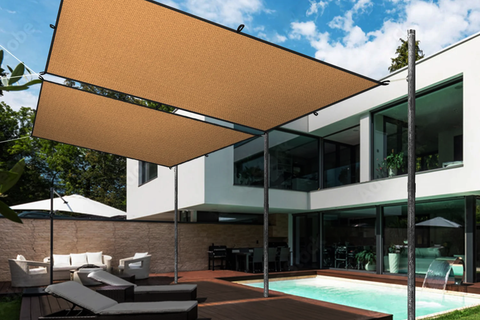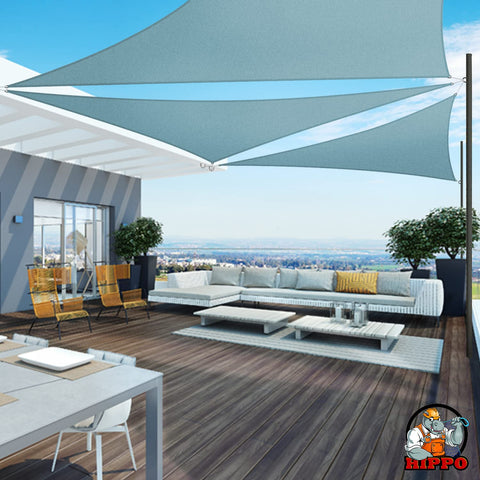The newest method to maximize your summer outdoor living area is to develop creative shade sail designs. They provide your family shade and UV protection, shielding them from the summer's intense heat.
When it rains, waterproof shade sails may shield you from precipitation, making outdoor time more comfortable. Because they are so simple to construct and come in various shapes to fit any taste, these semi-permanent structures are a great addition to any patio or garden.
These sensible and often inexpensive designs are among the best patio shade ideas available, whether you want to cover a small deck or a big outdoor eating area.
Describe a Shade Sail.Installing shade sails over the area you want to be shaded involves covering it with sail-like pieces of specially tailored cloth. In addition to being excellent for a backyard or patio at home, these sails also often shield the public from UV rays in commercial settings like playgrounds and restaurants. They block out 99% of UV radiation.
One of the main distinctions between a shade sail and an umbrella or awning is that the former resists dry rot and mildew, while the latter, due to its porous material, is impervious to raindrop accumulation on the sail.
Sailcloths with shade are very adaptable and have several uses! Ideas for shade sails include shielding playground equipment from the sun, covering outdoor eating areas, shading pathways, blocking excessive sunlight over ponds or gardens with partial sun, shielding outdoor animals from the heat and flying predators, and more. The ways in which you may enhance your outside area with a shade sail are almost endless!
How a Shade Sail Is Used?One of the most excellent things about shade sails is how simple it is to install them!
All the necessary installation gear is supplied when the shade sails are delivered. Attack the shade sail's corners to solid structures such as building walls, steel, wooden poles, etc., since they must be pulled taut to prevent blowing in the wind.
The mounting platform should be as sturdy as feasible since the turnbuckle will be under a lot of stress. Because of this, unless the tree has an unusually robust trunk, we do not advise attacking your shade sail to it. Never tie a shade sail to a tree limb because the branches will move with the wind and tug on the connection!
10 Short and Simple Shade Sail Ideas for Decks and PatiosThese creative shade sail designs provide shelter from the sun and rain, making them an excellent addition to any outdoor setting.
Thanks to the epidemic, we all spent more time outside, which was a positive development. Therefore, to create the ideal outdoor living space, we naturally feathered our outdoor nests with furniture, pillows, rugs, and accessories.
A sail shade is a fantastic substitute for gazebo designs if you prefer shade where you need it most. By adding a huge square design above, you may enjoy this area even in the warmest and brightest parts of the day, which also adds to the impression of having an "extra room" outside.
Ideas for awnings are great for sun-drenched gardens since they shade the spot where your dining table should be directly at the front of your house. As a result, you may keep your patio doors open without being concerned about your home being too hot.
The drawback of awnings is that, like many pergola ideas, they're likely to be somewhat pricey. Fortunately, a cheap rectangular shade sail can be used to make a setup similar to this. Just place two fittings on the wall outside your patio doors and fasten the other two outside corners to surrounding poles, trees, or walls.
"A sail shade can be a less expensive alternative to an awning," explains Primrose's gardening expert Evie Lane. Additionally, they have the advantage of being a more adaptable garden accessory than a fixed awning structure.
If you want to make sure that your patio furniture area is always fully shaded from the sun, use a large design. With the 98% UV protection of the Wayfair style seen here, you can enjoy warm weather outside without having to reapply sunscreen every hour.
Alternatively, a little version would be enough to shade a small patio if you don't have enough room for a giant sail. Ideas for small shade sails are a chic substitute for outdoor parasols and work for covering a bistro table.
It's common for shade sails to be supplied without the poles or fasteners required to erect them in your garden. Since the requirements of each shade sail setup vary based on your outside area, they may often be bought independently from the same supplier.
On the other hand, this hybrid gazebo/shade sail comes with everything you need to set it up freestanding in your yard immediately. The powder-coated steel structure resists corrosion, and the sail is fastened at many locations to provide firm and tight shade.
It highlights this urban backyard's primary outdoor dining area by creating an exquisite but understated deck cover.
Similar to patio umbrella ideas and awnings, shade sails are available in various colors, even though most are white.
If you're looking to add some flare to your garden without breaking the budget, check out these vibrant shade sail ideas, which will make a low-cost, cozy garden shelter.
This ManoMano collection offers eight hues, ranging from orange and blue to green and deep terracotta.
If you're sweating into your salad in the sweltering heat, the pleasure of dining outside may be somewhat tempered. A shade sail is an easy and affordable substitute for a pergola, even though it may be a tremendous shade-creating addition to an outdoor dining area if you don't have the time or resources to learn how to construct one.
By suspending a shade sail above, you and your guests may take advantage of the fresh air that comes with outdoor eating without having to sacrifice comfort while you dine.
A triangle shade sail looks excellent next to a cornet outdoor couch positioned against a tall fence or garden wall.
To ensure that everyone sitting receives the most shade when the sun is at its strongest, you may need to pick an equilateral form or a triangle design with two long sides and one short side, depending on the size and length of your couch. Attack it to the far edges on the two outside sides and the wall or fence in the corner.
While some individuals like being in the sun, others would rather stay cool in the shade.
Covering a square or rectangular sitting area with a tiny triangle shade can give everyone the pleasure of both possibilities. This way, everyone can choose a comfortable spot to sit.
The absence of shade while lounging outside on a picnic or camping trip is one of the problems. Shade sails are very portable, unlike features like garden arbors; all you need is a tree or vertical surface, along with a few lengths of rope to hang the corners from.
Additionally, they will shield you from an unforeseen downpour of rain. Just be careful to completely tension your sail so that the rainfall can drain off if it does decide to show up.
A hydrangea-filled patio with a gray garden table and matching shade umbrella.
Gray is a neutral color that makes any surrounding foliage seem more vibrant. If your cushions or furnishings are the same color as your yard, this is the perfect shade to tie the color scheme together.
Which Shade Sail Design Is Best for My Space?Shade sails are often shaped like squares, rectangles, right-angled triangles, and equilateral triangles. According to Claire Maclean, Founder and Director of Clara Shade Sails, "There is no size or shape that is any better than the next." "Everything depends on the area you're attempting to cover, the locations of your fixing points, and the amount of shade and weather protection you desire."
"It is advisable to purchase a shade sail that is marginally smaller than the desired coverage area," suggests Wayfair's resident style advisor, Nadia McCowan Hill. A smaller size keeps the sail from rattling about in gusty conditions and damaging the connection points structurally. You will draw the shade sail tight and stretch it as far as possible while installing it. Your shade sail's material must start 12 inches (30 cm) from your anchor point.
On a bright summer day, a little patio with sunshades made of yellow sails and a beautiful sky above
What Can Be Used for Posts with Shade Sail?"After deciding on the optimal location for your shade sail, Nadia advises determining the attachment points." These might be any solid structure, such as a pergola, home, a fence post, or a tree.
A Shade Sail Should Be Taut, But How?Many of our clients are content to tie their sails loosely if all they're looking for is a sail to provide some temporary shade. Installing in this manner produces a more voluminous appearance, which looks and functions well in both an indoor conservatory and a garden, especially with the smaller sails.
However, your sail should be drawn highly tight if you want to use it in inclement weather or leave it out as a more permanent addition to your patio ideas. The curved sides make this extra stress possible.
One of our clients described her successful installation as "tight as a drum." Water will flow off and not collect or puddle on top if they are installed at an angle and pulled tight.
Are Shade Sails Good for Rain?We suggest removing shade sails in severe weather, such as strong winds and intense rain.
If you plan to use a shade sail during wet weather, you must install it at an angle of 20-30 degrees, depending on its size, to allow rainwater to run off.
A diagonal line will be involved when some posts are taller than others, altering the length of your measurement. Two corners of a square or rectangle and at least one corner of a triangle must be positioned lower than the others. Even yet, nothing is lost if water pools on top. She advises pushing from underneath with a broom handle or something similar to get the water off the top.
ConclusionA growing number of people use shade sails to provide shade in their yards and other outdoor areas. They offer an adaptable, specially designed solution that can be adapted to meet your unique requirements. Consider ShopHippo Shade Sails Brisbane if you're searching for a distinctive method to offer shade to your garden. To ensure that you get the most out of this chic and helpful addition, we can assist you with creating the ideal sail for your area.




